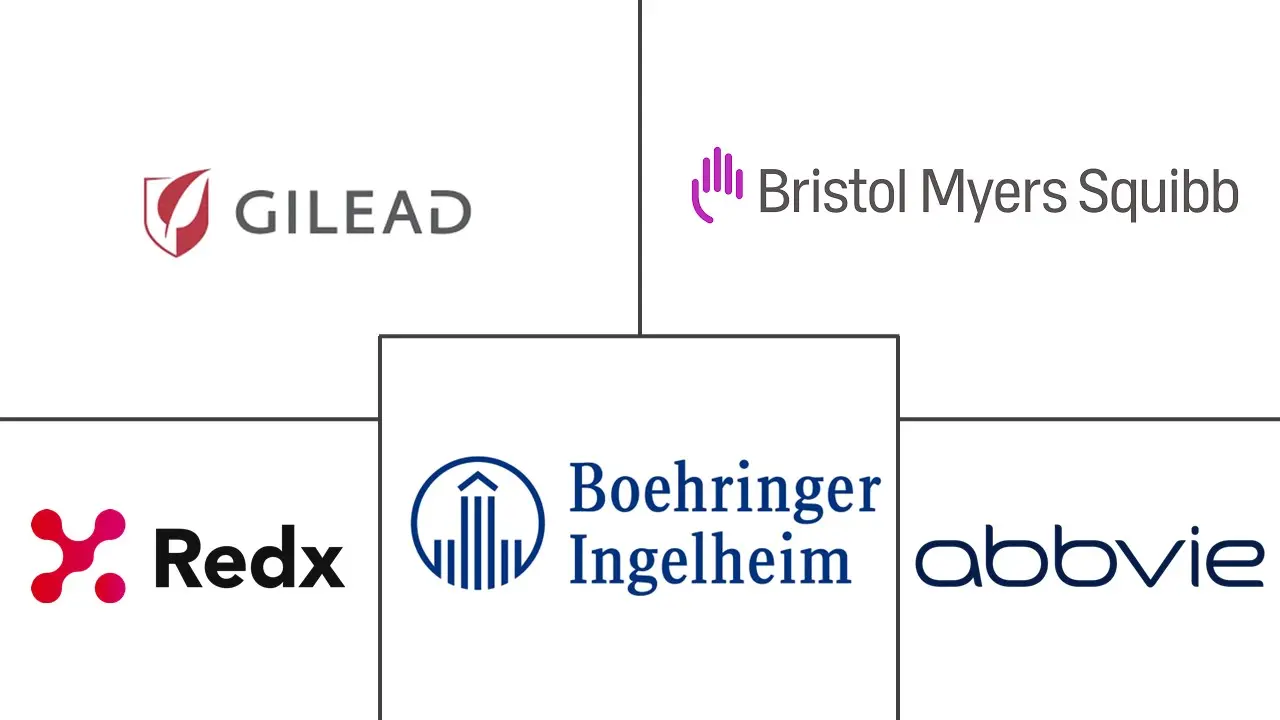Fibrotic Disease Treatment Market Size and Share
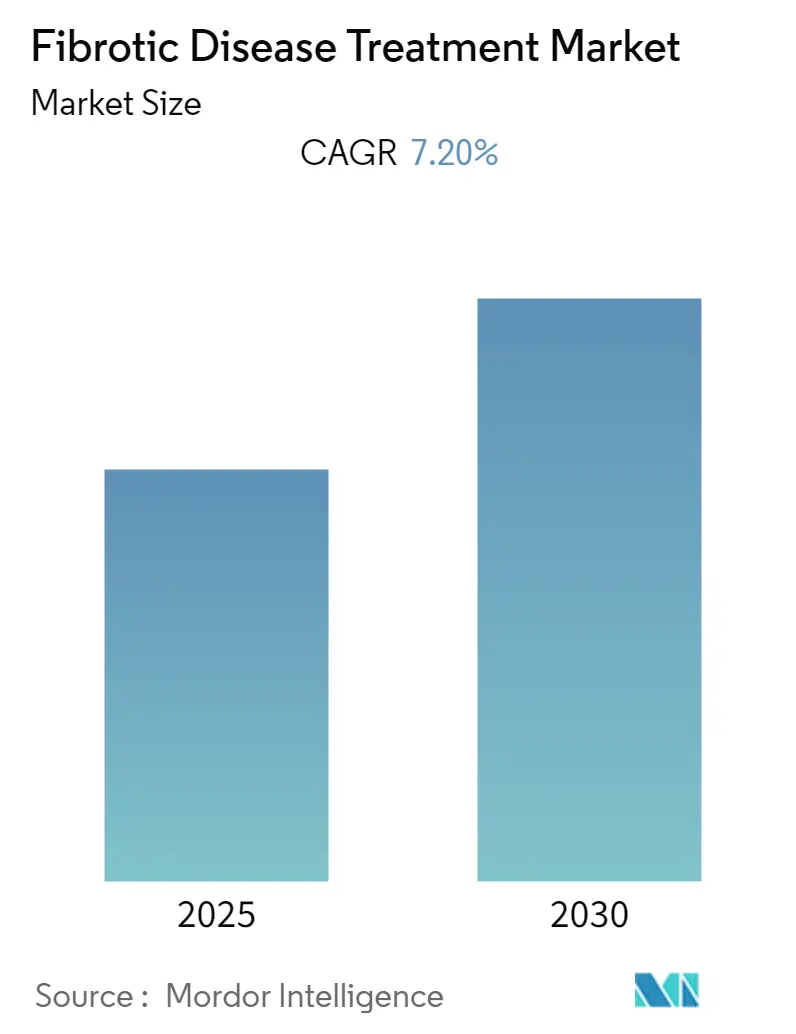
Fibrotic Disease Treatment Market Analysis by Mordor Intelligence
The Fibrotic Disease Treatment Market is expected to register a CAGR of 7.2% during the forecast period.
COVID-19 adversely affected the fibrotic disease treatment market. The COVID-19 patients were affected by pulmonary fibrotic dysplasia as a possible consequence of COVID-19 pulmonary pneumonia. For instance, according to the study published in the Annals of Medicine and Surgery in May 2022, approximately 44.9% of COVID-19 survivors appear to have developed lung fibrosis. People infected with COVID-19 severity factors were found to be more prevalent pulmonary fibrosis (PCPF). Thus, it indicates that people infected with COVID-19 are more likely to develop fibrotic diseases, and hence there was a substantial demand for fibrotic disease treatment during the pandemic. However, the market is growing at a steady rate due to an increasing patient population with fibrotic diseases, and this trend is likely to continue during the projection period.
The major factors driving the growth of the market are the growing burden of fibrotic diseases, the increasing number of smokers, and technological advancement in the treatment of fibrotic diseases.
The growing burden of fibrotic diseases such as pulmonary fibrotic diseases, hepatic cirrhosis, renal fibrosis, and cutaneous fibrosis is expected to increase demand for effective treatment medications, which is likely to boost the market over the forecast period. According to the American Lung Association data updated in November 2022, every year, around 50,000 new cases of IPF are diagnosed in the United States. The majority of IPF patients initially notice symptoms between the ages of 50 and 70. Furthermore, according to the article published in the British Medical Journal in September 2022, the estimated prevalence of idiopathic pulmonary fibrosis in specialized care was 36.0 per 100,000 in 2021. Thus, the growing burden of fibrotic diseases is likely to demand fibrotic disease treatment medication to effectively control and manage the diseases, which is likely to contribute to the market over the forecast period.
Moreover, the increasing number of cigarette smokers is expected to boost the market, as cigarette smoking is one of the risk factors for developing fibrotic diseases such as pulmonary fibrosis or lung fibrosis. For instance, according to the CDC updates published in May 2023, in 2021, approximately 12 out of every 100 adults in the United States aged 18 and above (11.5%) will smoke cigarettes, resulting in 28.3 million adult smokers in the United States. Cigarettes contain particulate matter and numerous chemicals that increase the swelling inside the body and hence lead to various diseases, including fibrotic diseases, which are likely to contribute to the market's growth.
Product launches, partnerships, and mergers and acquisitions will help the companies expand their product offerings and geographical footprints, thereby contributing to the lucrative growth of the market. For instance, in May 2022, Sandoz launched its generic pirfenidone, the first AB-rated (fully substitutable) equivalent to Genentech's Esbriet, to treat patients with idiopathic pulmonary fibrosis (IPF). This prescription oral medicine is immediately available to patients via speciality pharmacies, with a USD 0 co-pay program for eligible patients. The availability of generic medicine would increase the demand for treatment, thus increasing market growth.
Thus, all the aforementioned factors, such as the growing burden of fibrotic diseases and smocking current and strategic activities by the market, are anticipated to bode well for the market over the forecast period. However, the high cost of medication and treatment is expected to impede the market over the projected period.
Global Fibrotic Disease Treatment Market Trends and Insights
Medication Segment is Expected to Hold the Significant Share Over the Forecast Period.
There are several medicines available for fibrotic diseases, including pirfenidone and nintedanib. The segment is driven by the increasing prevalence of fibrotic diseases, rising research and development activities to bring novel and innovative medicine into the market, and strategic activities by the market players that are expected to boost market growth over the forecast period.
Research and development activities have significantly opened various avenues for the treatment of several diseases. The emerging technological advancements, along with the appropriate research, led to the formation of several drugs for the treatment of diseases. The medication slows illness progression and effectively treats diseases. Nintedanib (Ofev) and pirfenidone (Esbriet) inhibit a physiological process that contributes to lung scarring. They may prevent the progression of IPF and aid in breathing. While oxygen therapy can assist those, who are short of breath to stay active.
Most people associate a company's research and development function with the invention of new products. While inventions are important, the development of existing products is of equal significance, as consumer preferences are continually changing. For instance, according to ClinicalTrial.gov, as of April 2023, there were 5,001 trials under development for fibrotic diseases across 207 countries. Hence, the rising development of new and more effective therapies for fibrotic diseases will provide new opportunities in the fibrotic disease treatment market.
Moreover, increasing launches of the medication are expected to boost the segment's growth over the forecast period. For instance, in May 2022, Sandoz announced the United States launch of generic pirfenidone, which is an AB-rated (fully substitutable) equivalent to Genentech's Esbriet for the treatment of patients with idiopathic pulmonary fibrosis (IPF). Moreover, in June 2021, Genentech, a member of the Roche Group, announced the United States Food and Drug Administration's (FDA) supplemental new drug application (sNDA) and granted priority review for Esbriet (pirfenidone). In June 2022, another company, Accord Healthcare, Inc., also announced the addition of pirfenidone to its solid oral products portfolio. This new drug is therapeutically equivalent to Genentech's Esbriet and is approved to treat idiopathic pulmonary fibrosis (IPF).
Thus, the factors mentioned above, such as growing research and development activities and the introduction of new medications, are expected to boost the segment's growth over the forecast period.
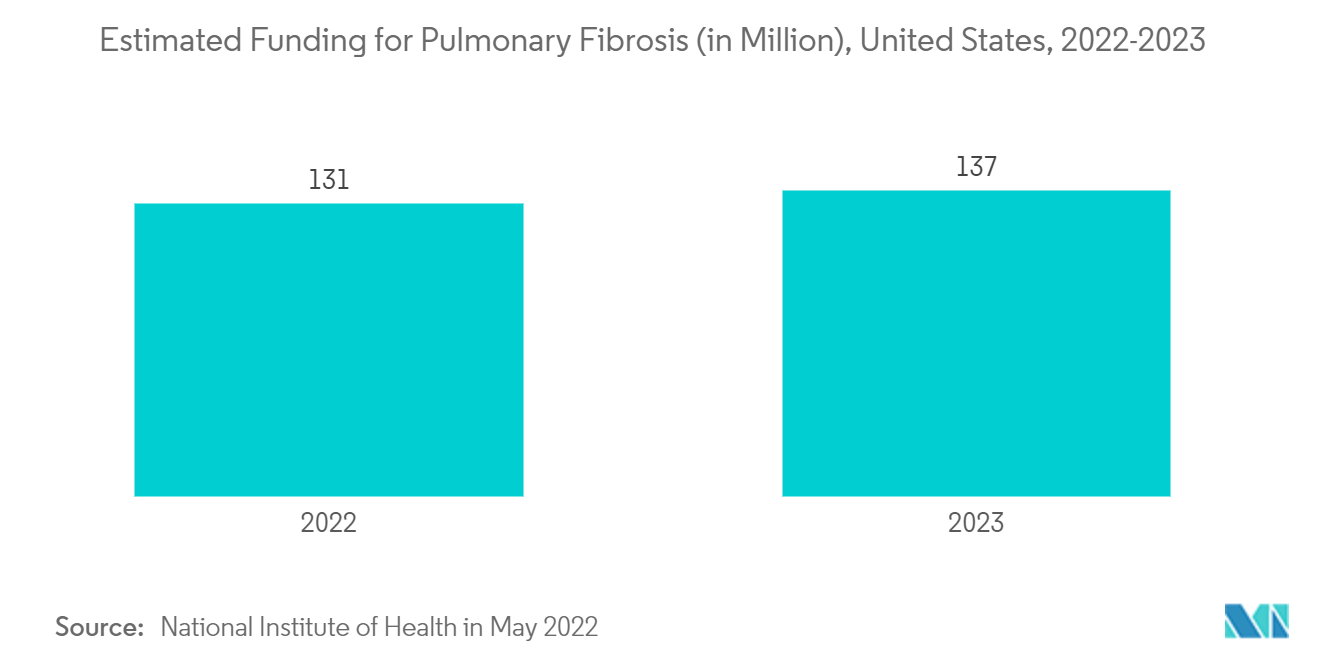
North America hold Significant Share in Fibrotic Disease Treatment Market Over the Forecast Period
The market for fibrotic diseases in North America is expected to experience lucrative growth during the study period due to the rising burden of pulmonary fibrosis and technological advancements in treatment in the studied market. In addition, product launches and strategic initiatives by key market players will also contribute to market growth.
The growing burden of fibrotic diseases such as cystic fibrosis (CF) is expected to boost the market for fibrotic disease treatment over the forecast period. According to the Cystic Fibrosis Report 2021, there were a total of 4,338 people with cystic fibrosis who visited one of Canada's 41 authorized CF clinics. There were 98 people newly diagnosed with cystic fibrosis, including 1,517 (35.0%) children and 2,821 (65.0%) adults, as well as 2,025 (46.7%) females and 2,313 (53.3%) men. In 2021. The entire Canadian CF population has been constantly growing. Thus, the growing burden of fibrotic diseases is projected to increase demand for fibrotic disease treatment medicine for effective control and management of the diseases, which is likely to contribute to the market throughout the forecast period.
The rising research and development operations for the treatment of fibrotic diseases may bring enhanced medicines to the market, making the drug available and accessible to patients. For instance, in September 2022, Bellerophon Therapeutics, Inc. stated that the FDA has accepted application to lower the study size for its current registrational REBUILD Phase 3 trial of INOpulse for the treatment of fibrotic interstitial lung disease (LD). Similarly, in October 2022, Boehringer Ingelheim reported that the first patient from the United States has enrolled in FIBRONEER-IPF, a global Phase III trial assessing BI 1015550, an experimental phosphodiesterase 4B (PDE4B) inhibitor, in persons with idiopathic pulmonary fibrosis (IPF). The trial is part of the FIBRONEER global program, which includes two Phase III studies: FIBRONEER-IPF in patients with IPF and FIBRONEER-ILD in adults with other progressive fibrosing interstitial lung disorders (ILDs).
Furthermore, considerable FDA approval in the country encourages companies to bring technologically sophisticated products to market, implying that increasing the availability of modern therapies to customers is projected to drive market growth. For instance, the FDA has given Istesso's BS2320 drug candidate Fast Track status for the treatment of individuals with idiopathic pulmonary fibrosis (IPF), a chronic illness that causes lung scarring. BS2320 is a metabolic reprogramming agent that has previously shown promise in treating rheumatoid arthritis symptoms and remodeling fibrotic tissue. Thus, due to the abovementioned factors, the studied market is expected to witness significant growth.
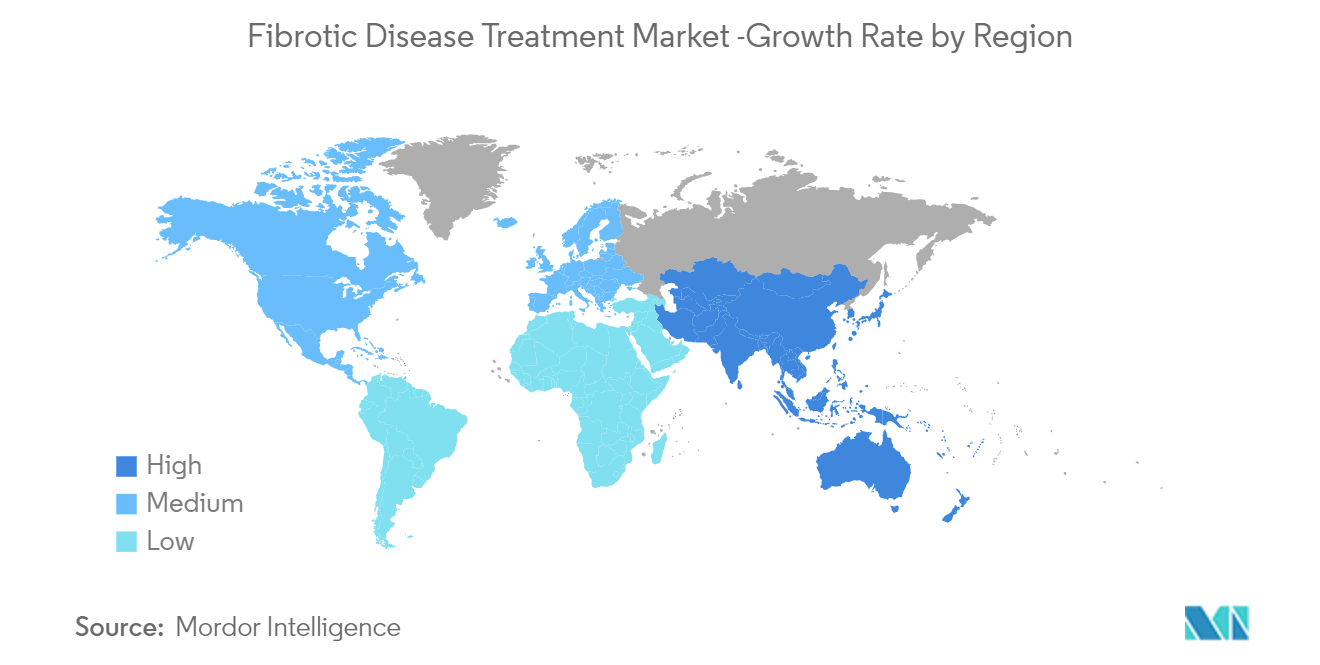
Competitive Landscape
The fibrotic disease treatment market is moderately competitive and consists of a few major players along with other small players in the market. The market players adopt various strategies such as collaboration, partnership, mergers and acquisitions, and global expansion to establish a strong position in the market. Some of the market players are Boehringer Ingelheim International GmbH, AbbVie Inc., Redx Pharma Plc, Bristol-Myers Squibb Company and others.
Fibrotic Disease Treatment Industry Leaders
Boehringer Ingelheim International GmbH
AbbVie Inc.,
Redx Pharma Plc
Bristol-Myers Squibb Company
Gilead Sciences, Inc.
- *Disclaimer: Major Players sorted in no particular order
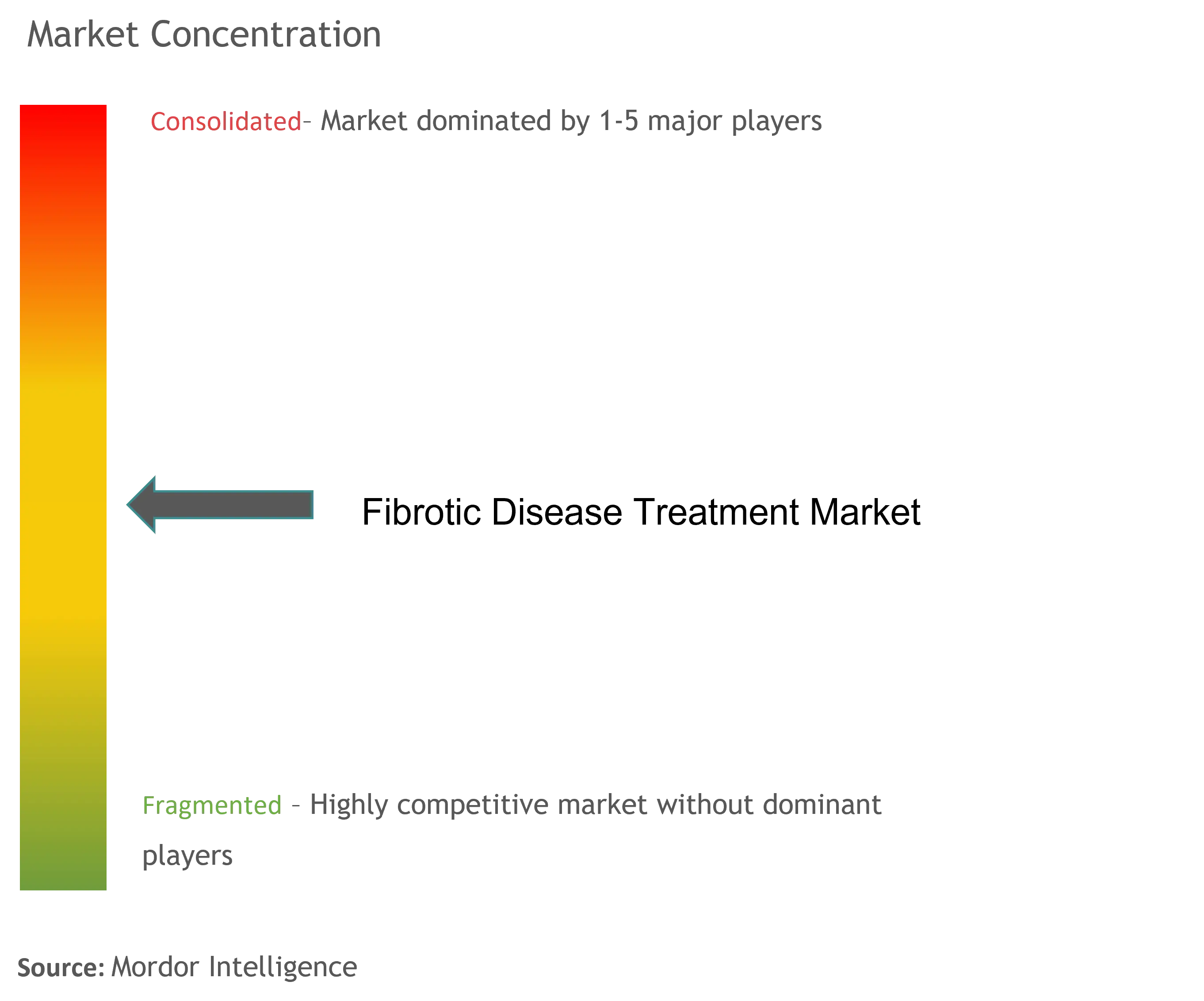
Recent Industry Developments
- May 2023: Boehringer Ingelheim said that it had begun clinical development of its first-in-class IL-11 inhibitor antibody, BI 765423, with a Phase 1 study (NCT05658107) to examine the safety, tolerability, and pharmacokinetics in healthy volunteers. Pre-clinical investigations have revealed that anti-IL-11 medication has the potential to inhibit and even reverse - fibrosis in many fibrotic illnesses.
- May 2023: Cumberland Pharmaceuticals Inc. reported that the FDA approved an Investigational New Drug Application (IND) for Phase II research in patients with Idiopathic Pulmonary Fibrosis, the most common form of progressive fibrosing interstitial lung disease.
Global Fibrotic Disease Treatment Market Report Scope
As per the scope of the report, fibrosis describes the development of fibrous connective tissue as a reparative response to injury or damage. Fibrosis may refer to the connective tissue deposition that occurs as part of normal healing or to the excess tissue deposition that occurs as a pathological process. Diseases characterized by uncontrolled, progressive fibrosis include Idiopathic Pulmonary Fibrosis (IPF), Non-Alcoholic Steatohepatitis (NASH), and Systemic Sclerosis (SSc). The Fibrotic Disease Treatment Market is segmented by Treatment (Medication, Organ Transplantation, Oxygen Therapy, and Others), Application (Idiopathic Pulmonary Fibrosis, Hepatic Cirrhosis, Renal Fibrosis, Cutaneous Fibrosis, and Others), End User (Government Organizations, Hospitals, and Academic and Research Institutes), and Geography (North America, Europe, Asia-Pacific, Middle East and Africa, and South America). The market report also covers the estimated market sizes and trends for 17 different countries across major regions globally. The report offers the value (in USD million) for the above segments.
| Medication |
| Organ Transplantation |
| Oxygen Therapy |
| Others |
| Idiopathic pulmonary fibrosis |
| Hepatic cirrhosis |
| Renal fibrosis |
| Cutaneous fibrosis |
| Others |
| Hospitals |
| Academic and research institutes |
| Others |
| North America | United States |
| Canada | |
| Mexico | |
| Europe | Germany |
| United Kingdom | |
| France | |
| Italy | |
| Spain | |
| Rest of Europe | |
| Asia-Pacific | China |
| Japan | |
| India | |
| Australia | |
| South Korea | |
| Rest of Asia-Pacific | |
| Middle East and Africa | GCC |
| South Africa | |
| Rest of Middle East and Africa | |
| South America | Brazil |
| Argentina | |
| Rest of South America |
| By Treatment | Medication | |
| Organ Transplantation | ||
| Oxygen Therapy | ||
| Others | ||
| By Application | Idiopathic pulmonary fibrosis | |
| Hepatic cirrhosis | ||
| Renal fibrosis | ||
| Cutaneous fibrosis | ||
| Others | ||
| By End User | Hospitals | |
| Academic and research institutes | ||
| Others | ||
| Geography | North America | United States |
| Canada | ||
| Mexico | ||
| Europe | Germany | |
| United Kingdom | ||
| France | ||
| Italy | ||
| Spain | ||
| Rest of Europe | ||
| Asia-Pacific | China | |
| Japan | ||
| India | ||
| Australia | ||
| South Korea | ||
| Rest of Asia-Pacific | ||
| Middle East and Africa | GCC | |
| South Africa | ||
| Rest of Middle East and Africa | ||
| South America | Brazil | |
| Argentina | ||
| Rest of South America | ||
Key Questions Answered in the Report
What is the current Fibrotic Disease Treatment Market size?
The Fibrotic Disease Treatment Market is projected to register a CAGR of 7.2% during the forecast period (2025-2030)
Who are the key players in Fibrotic Disease Treatment Market?
Boehringer Ingelheim International GmbH, AbbVie Inc.,, Redx Pharma Plc, Bristol-Myers Squibb Company and Gilead Sciences, Inc. are the major companies operating in the Fibrotic Disease Treatment Market.
Which is the fastest growing region in Fibrotic Disease Treatment Market?
Asia Pacific is estimated to grow at the highest CAGR over the forecast period (2025-2030).
Which region has the biggest share in Fibrotic Disease Treatment Market?
In 2025, the North America accounts for the largest market share in Fibrotic Disease Treatment Market.
What years does this Fibrotic Disease Treatment Market cover?
The report covers the Fibrotic Disease Treatment Market historical market size for years: 2019, 2020, 2021, 2022, 2023 and 2024. The report also forecasts the Fibrotic Disease Treatment Market size for years: 2025, 2026, 2027, 2028, 2029 and 2030.
Page last updated on:
Fibrotic Disease Treatment Market Report
Statistics for the 2025 Fibrotic Disease Treatment market share, size and revenue growth rate, created by Mordor Intelligence™ Industry Reports. Fibrotic Disease Treatment analysis includes a market forecast outlook for 2025 to 2030 and historical overview. Get a sample of this industry analysis as a free report PDF download.
